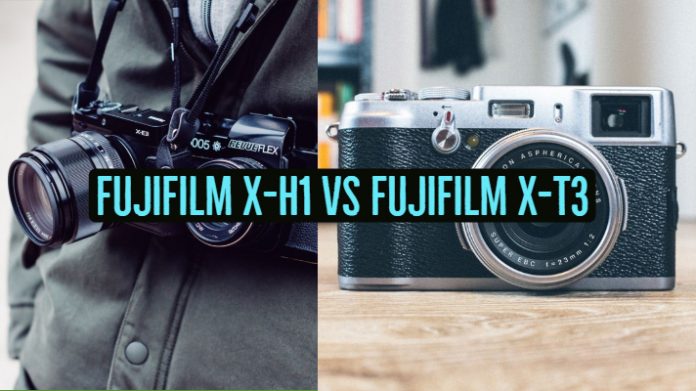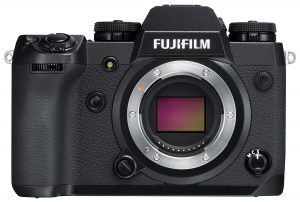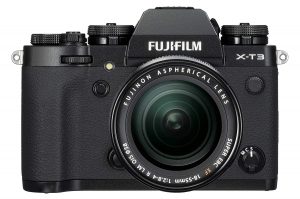Fujifilm has been one of the prominent players in the realm of offering the best cameras for the photography buffs. With the launch of the capable Fujifilm XH-1, the company has entered the much-needed area of 5 Axis in body stabilization options. We will compare the two strong contenders from Fujifilm (Fujifilm X-H1 vs Fujifilm X-T3) and see how they are positioned against one another.
Fujifilm X-H1 vs Fujifilm X-T3 – How Do They Compare?
The X–T3 is possibly the best and the most advanced camera from Fujifilm in recent times. However, the launch of Fujifilm X-H1 can be seen a step ahead of the functionality whether you consider it from its X series or the mirrorless cameras as a whole.
If you are looking to know more about the differentiation that these two cameras come with, here are our detailed comparison report based on a few key parameters.
Sensor Stabilisation
Like we mentioned already, the Fujifilm X-H1 is the first option in the X series to offer the in-body sensor stabilization. It provides you a 5 axis in body stabilization. You should be able to work with it either using the non-stabilized lenses or with stabilized ones in conjunction.
Though the X-T3 was launched much after the X-H1, it does not offer you in body sensor stabilization. The technology seems to limited and exclusive to the Fujifilm X-H1 as of now among all the Fujifilm cameras currently available. If you are looking for the stabilization options on your Fujifilm X-T3, you will need to depend upon the stabilized lenses for the purpose.
Autofocus
This is possibly the area where the XH 1 falls short of the X-T3. The latter comes with the hybrid autofocus system developed by Fujifilm.
The X-T3 offers you 117 phase detection points. That’s what you would get if you are opting for the 13 x 9 grid. If you are opting for a 17 x 25 grid, you can get 425 autofocus points. The numbers would be 91 for a 13 x 7 grid and 325 points on a 13 x 25 grid. The X-T3 offers 4x number of phase detection pixels in comparison to the X-H1.
Moreover, the X-T3 provides you full coverage of the sensor for the autofocus covering 99 percent of the width and height. The X-H1 comes with coverage for only the central part of the sensor. The low light autofocus functionality is again better placed on the X-T3 than the X-H1. The numbers are -3V opposed to the -1V. You would also be blessed with a better face and eye detection performance on the newer X-T3 than that on the X-H1.
The Physical Properties
The flagship model Fujifilm X-H1 offers a better-enlarged grip option. This can be helpful in handling the larger telephoto lenses.
The physical dimensions of the Fujifilm X- T3 read 132.5 x 92.8 x 58.8mm, and that of X-H1 are 139.8 x 97.3 x 85.5mm. The weight of the two competing siblings is 539 grams and 673 grams. The body on the X-H1 is more robust and offers durability. You also have access to the scratch resistant surface.
Video Shooting Capabilities
In spite of being the flagship model, the X-H1 once again falls short of expectations in comparison to the X- T3. The latter offers a higher frame rate for 4K video shooting. It also comes with faster bitrate as well. The customization options available on the X- T3 are indeed far better than those on the X-H1. The camera is indeed the first when you are looking for 4K recording at 60p at 10 bit.
The cropping in 4K recording on the Fujifilm HX 1 is 1.17X while the same on the X-T3 is slightly better at 1.18X. That would put both of them on the same level. For the 1080p recording, either of them can record at 60 fps or 120 fps. However, you would find a higher bit rate at 200 Mbps on the X-T3 compared to the 100 Mbps on the X-H1.
The specifications for video recording are as follows:
| 4K up to 30 fps | 4K up to 60 fps |
| 4K at 200 Mbps | 4K at 400 Mbps |
| External recording in 4:2:2 8-bit | External recording in 4:2:2 10-bit |
| Internal recording in 4:2:0 8-bit | Internal recording in 4:2:0 10-bit |
| H.264 codec | H.264 and H.265 codecs |
Battery Performance
Both of them use the same battery pack – the NP-126S. However, the battery backup on both of them differs considerably. The Fujifilm X-T3 provides you with up to 390 shots per single charge. The X-H1 falls considerably lower end with 310 shots on a single charge.
If you are shooting in 4K, you will get around 35 minutes on the X-H1, while the X-T3 can squeeze in up to 40 minutes. Attaching a vertical battery grip can improve the performance though. Please note that the ratings available are the only representative and may not be the actual results. You would be able to get a better option than those specified.
What are The Benefits of Fujifilm XH-1 over Fujifilm X- T3?
Well, we would prefer the following features on the X-H1 in comparison to the X–T3 –
- You can check the shooting parameters with the control panel.
- The LCD offers a fully flexible design for those shoots where you need to place the camera at odd angles.
- You have access to better burst performance.
- The stabilization technology will ensure sharper images.
- Better grip will make it best suited for larger telephoto lenses
What Advantages Does The X-T3 offer over XH 1?
Well, in contrast, the X-T3 comes with the following advantages –
- Better video shooting capabilities.
- Better battery backup
- The screen is more significantly larger at 3.2 inches compared to 3 inches of the XH 1
- It is of more recent origin.
- Affordable pricing.
The Concluding Thoughts
Well, one thing is sure. The Fujifilm has presented the X-H1 as the flagship model, but all the accolades go with the newly launched Fujifilm X-T3. It introduces a host of new concepts and features including 4K recording at 60 fps, enhanced autofocus and burst shooting capabilities and new sensor technology. We would consider the X- T3 to be one of the best options for your video shooting and other photography requirements.
It indeed beats the flagship model in almost every respect. Check it out once, and you will find out the truth.



